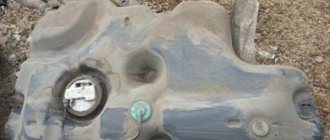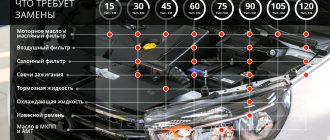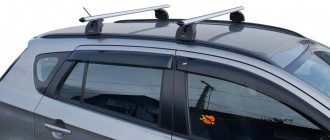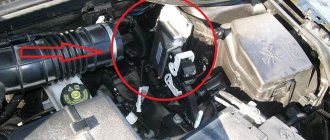Fuel tank volume
Gas tank Lada Vesta
When purchasing a car, most future owners are interested in the capacity of the fuel tank. The vehicle's range is the distance the car can travel when the gasoline indicator begins to signal the last drops of fuel inside.
The volume of the Lada Vesta fuel tank directly affects the distance covered by the car on its last breath. The most common numbers in the capacity parameter: 40, 50, 60, 70 liters. These figures clearly indicate the size of the vehicle. Accordingly, there are subcompact models, mid-size and full-size cars.
Lada Vesta tank volume - how long can you drive?
In Lada Vesta, the tank volume according to the vehicle’s technical passport reaches 55 liters. And this is an excellent result for the Lada Vesta and its fuel tank volume. If we take previous modifications of the vehicle, then the largest capacity reaches 50 liters. Among foreign cars, the Vesta sedan is similarly superior, beating Rio and Solaris by as much as 12 hp. Read the article and find out the competitors’ capacities and the secrets of the power reserve!
The power reserve with a completely filled tank according to the BC (PC) is 693 kilometers. However, when installing LPG, the mileage reserve can be increased even by 1000 kilometers, which for the owner can be a key factor when installing gas equipment. Let us remember that changes have occurred in the legislative field; now the presence of gas equipment must be recorded - STS of the vehicle.
If you need a gas tank for Vesta, then its catalog number (article) is 8450008544.
How much fuel can you actually put in Vesta's tank?
The Vesta tank size is 55 liters; it is possible to use a filler pipe for the tank, which will increase the introduced fuel size. If you pour gasoline all the way, shooting the pistol and regularly topping up, then the car’s tank will hold 58 liters. Whether a 60-liter unit will fit has not yet been fully studied, but if it does, there will be fluctuations in the results of the meter at the station’s filling machine.
During the release of the Lada Vesta, the tank volume will change for other cars of the VAZ family, in order to fully satisfy the car owner. An increase in the volume of Kalina's tank is expected soon5 from 43 to 50 liters.
How far can you drive when the fuel light comes on?
If the indicator - the capacity of the fuel tank of the Lada Vesta has dropped to the scarlet mark, then there are approximately 7-8 liters left in the tank. It’s better not to take too long with fuel and refueling.
The material used in the manufacture of the fuel tank is plastic, and this is important for the current driver. It contains a thermal protection function against the resonator mechanism and the muffler.
They say: Despite its significant capacity, pouring fuel from a car is easier than usual, similar to most all types of Zhiguli (Lada models). is this true, look in the video
The manufacturer did not think about the system for closing the tank hatch, and about the mesh in the fill neck. A hatch with a lock is only available in Lada Vesta Cross models. In fact, Vesta owners install a Logan lid with a lock. The price of such a Chinese copy is 350 rubles.
The capacity of the tank, together with the economical consumption of gasoline or gas (the real fuel consumption of the Lada Vesta), makes this model a “monster” of the road.
Tank of Lada Vesta's closest competitors:
- Kia Rio - 50 l;
- Hyundai Accent - 45 l;
- Polo - 55 l;
- Skoda Actavia - 50 or 55 l;
- Ford Focus - 55 l.
The more common volumes of fuel tanks in cars are: 40, 50, 60, and also 70 liters. According to the capacity of the gas tank, it should be noted what degree of engine volume the car has. If the tank is designed to hold 30 liters, then we are talking about small cars. 50 or 60 l. - this is average. And 70 speaks of a car with a large volume.
A large tank size would not be required if fuel consumption was not such an important parameter. Understanding the average fuel consumption, it is easy to determine how many kilometers a car will travel with a full tank of fuel. The BCs of current cars can quickly show these indicators.
Cruising range on gasoline - if the tank is full
The size of a gasoline tank in the same modification can vary. Vesta owners report that the tank usually holds from 54 to 57 liters. gasoline. Once the car's fuel tank is filled to the brim, the car's PC will demonstrate that there is enough fuel for 695 km (due to negligible costs). Experts report that by installing special gas equipment, the vehicle’s range without refueling gasoline can be increased to another 300 km.
Experts agreed with the conclusion that the fuel reserve of a full tank of the Lada 2190 is considered significant. This means that the car owner is able to confidently cope with long distances without worrying about fuel. In fact, the car PC does not regularly show the highest possible mileage on a single fill-up.
Gas range of Vesta CIS
If we compare a “gas” car in daily use, then using a methane car is more economical. The price of compressed natural gas is 3 times more economical than fuel. By all parameters, it turns out that the more the owner drives, the cheaper it is to use the car. The unconditional superiority of the Lada Vesta CIS is its overall range.
With smooth trips on gas, you can travel 350 kilometers, plus 750 km on fuel, and that’s 1,100 km. This sedan will be able to travel a significantly longer distance than its classmates in other Lada models.
Conclusion
The fuel limit indicator in the car PC fixes the mark at 8 liters, which provides a significant reserve in order to freely get to the gas station. The tank capacity of the Lada 2190 will not disappoint consumers of the Vesta car. Drawing conclusions, we note that the car is suitable for driving around the city and over long distances.
When to make the first replacement
The first fluid change should be performed after 1-3 thousand km. After draining it, in most cases we will see how bad its condition is. Extending this oil to 15,000 would be a bad idea, as there is a risk of coking the engine.
Vesta is equipped with two power units from a domestic manufacturer, 106-horsepower (model 21129) and 122-horsepower (model 21179). These are modern, high-speed engines, their parameters are taken into account when selecting fluids.
Manufacturers recommend choosing better from 5W30 or 5 W40 oils (adjusted for summer and winter temperatures in the region where the vehicle is operated)
What is the volume of the fuel tank on the Lada Vesta
The Lada Vesta car has a tank volume, which directly affects the distance traveled by the vehicle on its last breath.
The most common capacity is 40, 50, 60, 70 liters. These figures depend on the size of the vehicle. There are subcompact, mid-size and full-size cars.
Capacity in accordance with the technical data sheet.
The tank volume of the Lada Vesta, as indicated in the documentation, is 55 liters. This applies to all trim levels and models of new products from AvtoVAZ. Professionals believe that this is a high level of capacity, since the main competitors Kia Rio and Hyundai Solaris have a volume of only 43 liters.
It is worth noting that in practice, these parameters do not always correspond to reality. There are examples when more fuel is poured into the fuel tank than is written in the technical data sheet. In such cases, the average increase in volume is from two to five liters
Lada Vesta is manufactured with 1.6 and 1.8 liter engines and has bellows
nic and robotic transmission. Fuel consumption is an important indicator, which can vary from 7 to 7.5 liters per 100 kilometers during a mixed driving cycle.
The fuel tank of the Lada Vesta is made of plastic, which is now relevant for the automotive industry. It is equipped with thermal protection against a silenced resonator.
Fuel tank Lada Vesta
You need to know certain features of the device in operation:
- according to survey results, volume is directly related to the car model;
- car owners say that during the first refueling cycle, up to 57 liters of fuel can be placed in the tank;
- the indicator that controls the gasoline level begins to light when about 8 liters remain;
- if the amount of fuel has reached the maximum level, the computer sensor will show that there is enough gasoline to cover 700 kilometers.
It must be remembered that Lada Vesta can be filled with 92 and 95 gasoline. The latter accelerates the vehicle more often and faster. Fuel with 92 number is cheaper. Consumers use such fuel to save money, but such savings are not always reflected well on engine components.
Results
The fuel tank of the Lada Vesta has good capacity, surpassing some foreign cars in volume. This provides great benefits for car owners to not have to worry about...
frequent visits to gas stations.
Indicators that are triggered when a critical amount of fuel on the Lada Vesta computer begin to signal at around 8 liters, which makes it possible to easily get to the gas station.
The fuel tank capacity of the new product from AvtoVAZ should completely suit the buyers of this car, which lays claim to future superiority within the domestic sales market.
Results
The fuel tank of the Lada Vesta has a very large capacity, surpassing some foreign representatives in this indicator. This provides enormous benefits for car owners who do not have to think about frequent visits to gas stations with such a fuel volume.
The indicators of the critical amount of fuel on the Lada Vesta on-board computer are triggered at around 8 liters, which gives a lot of time to easily get to the gas station. The tank capacity of the new product from AvtoVAZ should not disappoint buyers of this car, which claims further superiority within the Russian sales market.
Fuel tank volume Lada Vesta
When purchasing a car, most future owners are interested in the capacity of the fuel tank. The vehicle's range is the distance the car can travel when the gasoline indicator begins to signal the last drops of fuel inside.
The volume of the Lada Vesta fuel tank directly affects the distance covered by the car on its last breath. The most common numbers in the capacity parameter: 40, 50, 60, 70 liters. These figures clearly indicate the size of the vehicle. Accordingly, there are subcompact models, mid-size and full-size cars.
Practice shows
From actual operation, the following can be said about the capacity of the tank:
- The indicator depends on the make of the car.
- When initially refueling a new car, 57 liters can enter.
- An indicator on the instruments warns the driver when 8 liters of fuel remain.
- With a full tank, the computer can display a range of 695-700 km.
Lada Vesta can be filled with 92 or 95 gasoline, but the latter is more preferable.
92 gasoline is poured in to save money, but this negatively affects the engine's service life. If you can share your experience of operating this X-style car, then write to us in the comments.
Fuel tank volume Lada Vesta sedan
For many people who want to buy a car, the tank volume is a decisive factor. It depends on how many kilometers the car will have enough gasoline. Today we will find out what volume Vesta’s tank has.
Capacity
The manual from AvtoVAZ tells us that the tank volume of the Lada Vesta is 55 liters. This figure is superior to competitors. For example, in the Hyundai Solaris the gas tank contains only 43 liters. It is made of plastic, unlike other cars from this manufacturer.
In practice, it is known that in fact 10% more fuel can enter Vesta’s tank.
The average increase in fuel is in the range of 2-5 liters. Vesta is produced with 1.6 and 1.8 liter engines and is equipped with mechanical and robotic gearboxes. Gasoline consumption in the combined cycle is 7.5 liters per 100 km.
Power reserve
According to the results of practical tests of car owners, the capacity of the gas tank differs between different cars of the same brand. Some drivers claim that the gas tank holds up to 57 liters, others - only 54 liters. After filling it up to the neck, the computer says that the estimated range is 695 km.
Experts say that after installing gas equipment on the Lada Vesta, you can drive another 300 km without additional refueling.
The fuel capacity of this brand of car exceeds that of many foreign cars. Therefore, the owner may not be afraid to drive long distances, and not worry that gasoline will soon run out.
The on-board computer does not always show the correct mileage information.
Practice shows
From actual operation, the following can be said about the capacity of the tank:
- The indicator depends on the make of the car.
- When initially refueling a new car, 57 liters can enter.
- An indicator on the instruments warns the driver when 8 liters of fuel remain.
- With a full tank, the computer can display a range of 695-700 km.
Lada Vesta can be filled with 92 or 95 gasoline, but the latter is more preferable.
92 gasoline is poured in to save money, but this negatively affects the engine's service life. If you can share your experience of operating this X-style car, then write to us in the comments.
Dimensions
Chassis
Fuel
Engine
The most common fuel tank sizes in cars are 40, 50, 60 and 70 liters. Judging by the volume of the tank, you can tell how big the car is. In the case of a 30 liter tank, we are most likely talking about a small car. 50-60 liters is a sign of a strong middle peasant. And 70 indicates a full-size car.
The volume of the fuel tank would be a useless quantity if it were not for fuel consumption. Knowing the average fuel consumption, you can easily calculate how many kilometers a full tank of fuel will last you. On-board computers of modern cars are able to quickly show this information to the driver.
The fuel tank volume of the Lada Vesta is 55 liters.
How much fuel does a standard Lada Vesta tank hold?
In the Operation Manual in the “technical specifications” section it is written that the capacity of the Lada Vesta’s fuel tank is 55 liters . Is this too much? Yes, enough. If we take previous VAZ models, the maximum capacity is 50 liters. As for foreign car competitors, Vesta is also the leader here, ahead of Rio and Solaris by as much as 12 liters.
The range with a full tank according to the BC (on-board computer) is 693 km. But when installing HBO, the power reserve can be increased up to 1000 km. Let us remind you that there have been changes at the legislative level; now the presence of LPG must be confirmed in the vehicle’s STS, but that’s not what we’re talking about now..
How much fuel can you actually put in the tank?
Despite the fact that the volume of the Vesta tank is 55 liters, you can also use the volume of the filler pipes in the tank, which will increase the capacity. If you fill it up to the very neck with pistol shots and constant topping up, then the tank in Vesta will hold 58 liters . I don’t know whether 60 liters will fit, I haven’t personally tried it, but if it does, then doubts will arise about the meter at the gas station)).
By the way, it is possible that during the production of Vesta, the volume of the fuel tank will be changed in order to please the car owner as much as possible. So, using an example, we can answer the increase in the tank on Kalina from 43 to 50 liters.
When does the fuel light come on?
If the gasoline level drops to the red zone, then there are approximately 7-8 liters of gasoline left in the tank. Therefore, it is better not to wait too long with refueling.
Video of refueling an empty Vesta tank
In the video, the author fills Vesta with 98 gasoline. but is it worth it? We'll talk about this in the next article: What fuel to use? 92 or 95?
The fuel tank material is plastic, which is quite relevant for the modern automobile industry. Has thermal protection from the resonator with a muffler. Despite the large capacity, draining gasoline from Vesta is as easy as shelling pears, as in all Zhiguli cars) The manufacturer did not think through closing the gas tank flap or the mesh in the filler neck. The cap is in the filler neck, what should I do?
A spacious tank, coupled with acceptable fuel consumption (Real fuel consumption of the Lada Vesta), makes the Lada Vesta a highway killer. For complete comfort, all that remains is to add lumbar support and more comfortable seats, so as not to get tired at all while driving. Home page
Capacity
The manual from AvtoVAZ tells us that the tank volume of the Lada Vesta is 55 liters. This figure is superior to competitors. For example, in the Hyundai Solaris the gas tank contains only 43 liters. It is made of plastic, unlike other cars from this manufacturer.
In practice, it is known that in fact 10% more fuel can enter Vesta’s tank.
The average increase in fuel is in the range of 2-5 liters. Vesta is produced with 1.6 and 1.8 liter engines and is equipped with mechanical and robotic gearboxes. Gasoline consumption in the combined cycle is 7.5 liters per 100 km.
Technical characteristics of Vesta sedan
- Body
The lineup
- Granta sedan
- Granta liftback
- Granta hatchback
- Granta station wagon
- Granta Cross
- Granta educational
- Granta Drive Active
- Vesta sedan
- Vesta Cross
- Vesta SW
- Vesta SW Cross
- Vesta CNG
- Vesta Sport
- XRAY
- XRAY Cross
- Largus station wagon
- Largus Cross
- Largus van
- Largus van CNG
- Niva
- Niva Off-road
- 4x4 3 doors
- 4x4 Urban 3 doors
- 4x4 5 doors
- 4x4 Urban 5 doors
- Concepts
- Commercial vehicles
- Models. Archive
Sections of the site
- News
- Stock
- Dealers
- LADA Finance
- LADA Leasing
- Test Drive
- Accessories LADA
- Ask a Question
Other sites
- 40 years 4x4
- 50 years of history
- LADA Sport
↑ Third maintenance, mileage 45,000 km
Lada Vesta SV cross volume.
technical characteristics of Lada Vesta sw cross. ground clearance of Lada Vesta SV Cross For SW CROSS, SW, CROSS, sedan, regardless of engine size, the cost will be (thousand rubles):
- for the first maintenance – 5.4;
- for the second – 7.5;
- for the third – 5.4;
- for the fourth – 7.5;
- for 5 – 5.4;
- for 6 – 14.6.
CNG maintenance costs (thousand rubles):
- at the first maintenance – 10.8;
- the second – 12.8;
- third – 10.8;
- fourth – 12.8;
- fifth – 10.8;
- sixth – 20, 361,
The first maintenance after 15,000 km of mileage or 1 year of operation after purchase is carried out in certified centers that have an agreement with official dealers. From this moment on, all work performed is noted in the service book. It contains the necessary list of such works. The car owner needs to check their volume and quality in a timely manner.
Attention! Provided the zero maintenance cycle is completed, there will be fewer problems with maintenance-1. The required scope of work during the initial inspection includes:. The required scope of work during the initial inspection includes:
The required scope of work during the initial inspection includes:
- changing the oil and filter, cabin air filter, drive belt;
- checking the tightness and level in the cooling system and fuel system;
- condition of brake pads, steering, front and rear suspension;
- operation of the generator, windshield wiper, heated seats, heated rear window, climate control system;
- checking the health of the battery (amount of electrolyte and charge density);
- serviceability of electric windows, mirrors, door locks
- drainage system.
Thus, all major vehicle systems are subject to diagnostics:
- steering;
- chassis;
- brake system;
- transmission;
- accumulator battery;
- electrical equipment;
- tightness of hoses and connections;
- locks.
The car body is checked for corrosion and chips. In operating mode, the engine and gearbox are listened to to determine uncharacteristic noises and knocks.
Detected deviations are eliminated with a corresponding note in the service book.
TO-3 the car must pass through 45,000 km. The cycle repeats the first technical inspection.
The same amount of work is performed:
- Change of oil;
- air filter;
- cooling system inspection;
- brake system;
- wheel condition;
- pendants;
- transmissions;
- batteries;
- electrical equipment;
- drainage system.
Gas tank Lada Vesta
The gas tank of a vehicle is an important component; unfortunately, at the moment they have not yet released a model that does not require fuel in any form. The volume of the fuel tank is also important, because the distance that the car can travel without refueling depends on the maximum volume. For passenger models, manufacturers try to install a tank of a volume that is enough for plus or minus 500 kilometers of autonomous driving.
On cars of the Lada Vesta family, the location of the gas tank is almost the same. It is installed in front of the axle of the rear wheels, as a result of which it is located directly under the sofa of the rear row of seats, by removing which you can gain access to the fuel pump.
Refueling is carried out through the gas tank flap, which is located on the right on all models of the family; by the way, there is an indicator on the dashboard indicating which side the gas tank neck is located on. The function is very useful for those who have just bought a car, drove to a gas station and remembered that they do not know which way to approach the gas station. Finding the indicator is quite simple, it is located in the right well (see photo below), which also displays the current volume of the fuel tank, as well as the engine temperature.
What is the real volume of the fuel tank on cars of the Lada Vesta family
On all models of the family, the gas tank has a fixed volume of 55 liters, the figure is indicated by the manufacturer and is official. Most experiments with refueling and calculating the occupied capacity of gasoline in the fuel tank confirm the data presented. However, several owners managed to fill their Lada Vesta with several liters more, most likely due to deception on the part of the gas stations whose services they used.
The dual-fuel Lada Vesta CNG has two fuel tanks installed at once, a regular gasoline tank with a volume of 55 liters and a gas cylinder with a volume of 90 liters, for refueling the corresponding type of fuel.
Depending on your personal driving style, a gas tank with a capacity of 55 liters will be enough for approximately 600 kilometers of road without refueling. However, it is worth considering that long driving with a small amount of gasoline in the tank is highly not recommended. The fact is that the gas pump installed in the gas tank is cooled by fuel, if the level is low, cooling occurs more slowly and the gas pump motor may fail prematurely.
Also, don't forget to use the on-board computer when planning your next fuel stop. The on-board computer system has functionality that calculates how many kilometers of road the current amount of fuel will last; the calculation is made taking into account your driving style and the amount of fuel spent over the previous 100 kilometers.
How to open the gas tank flap on Lada Vesta cars
On the first Lada Vesta, the gas tank flap did not have a locking mechanism, as a result of which anyone could open it.
Car owners and car reviewers did not like this design at all. AvtoVAZ quickly responded to this defect and soon cars appeared with a key for the neck cover, and a little later the hatch itself acquired a locking mechanism. In order to open the gas tank flap, just press your finger on the left side of the hatch, while the central lock of the Lada Vesta must be unlocked, since it also blocks access to the gas tank.
Preparation
First of all, you need to prepare the car for work. To do this, the sedan is placed on a lift (two-post) and placed on the handbrake. Then you need to throw the rear sofa cushion forward.
Remove the fuel pump hatch cover (No. 1 in Fig. 7-2).
Next, disconnect the plug (No. 3) from the electric fuel pump module (No. 1) - indicated in Fig. 7-3.
You need to start the engine and let it idle until it stops completely. This will relieve pressure in the fuel system and remove exhaust. Afterwards the key is removed from the ignition switch.
Next, you need to remove the “-” terminal from the battery by unscrewing it with a 10mm key. Then raise the car a little to drain the fuel from the gas tank. During operation, you should be careful to prevent gasoline leakage.
Finally, all that remains is to remove the rear right wheel.
Lada Vesta tank how many liters
Cruising range on gasoline if the tank is full
Practice shows that the volume of the West tank differs by 1–2 liters, even in the same version with the same modifications. The maximum possible volume of fuel that could be filled was 57 liters. As soon as the tank is filled to capacity, the fuel control system will inform the driver that the current reserve is 693 or 695 kilometers. In combination with gas equipment, this figure can be increased by another 300 km, resulting in a total reserve of about 1000 km.
In the current range of various modifications, there are models with engines of 1.6 and 1.8 liters. Plus, the possible power reserve is affected by the type of transmission, which may also differ in different models. On average, taking into account all of the above, fuel consumption per 100 km is from 7 to 7.5 liters when driving mixed. The maximum possible range on gasoline with a full tank becomes many times greater when using methane. In comparison with the average cost of this gas and fuel, daily driving a Lada Vesta costs at least 3 times less. With LPG installed, you can drive about 350 km on gas alone. With the use of fuel, this distance will increase by another 750 km, and, in total, this figure is an impressive 1100 km, which significantly exceeds similar models of the Lada family.
How much fuel can you actually put in the tank?
Despite the fact that the volume of the Vesta tank is 55 liters, you can also use the volume of the filler pipes in the tank, which will increase the capacity. If you fill it up to the very neck with pistol shots and constant topping up, then the tank in Vesta will hold 58 liters . I don’t know whether 60 liters will fit, I haven’t personally tried it, but if it does, then doubts will arise about the meter at the gas station)).
By the way, it is possible that during the production of Vesta, the volume of the fuel tank will be changed in order to please the car owner as much as possible. So, using an example, we can answer the increase in the tank on Kalina from 43 to 50 liters.
When does the fuel light come on?
If the gasoline level drops to the red zone, then there are approximately 7-8 liters of gasoline left in the tank. Therefore, it is better not to wait too long with refueling.
Capacity according to technical data sheet
Compared to previous versions, the value has increased by 5 liters. since according to official data in the documentation, the volume of the Lada Vesta fuel tank is 55 liters. Many auto industry experts agree that this is a decent value for the small class. The popular foreign analogues of Rio and Solaris have a tank capacity of 12 liters less.
The data specified in the car owner's documentation does not always truthfully tell you what the volume of the Lada Vesta tank is. You can read a lot of examples online where car owners managed to fill the tank with 2 or even 5 liters more than stated in the instructions.
Results
The fuel tank of the Lada Vesta has good capacity, surpassing some foreign cars in volume. This provides excellent benefits for car owners to avoid having to think about frequent visits to gas stations.
Indicators that are triggered when a critical amount of fuel on the Lada Vesta computer begin to signal at around 8 liters, which makes it possible to easily get to the gas station.
The fuel tank capacity of the new product from AvtoVAZ should completely suit the buyers of this car, which lays claim to future superiority within the domestic sales market.
How much does the tank hold according to the owners?
Operating practice shows interesting nuances of handling the Lada Vesta gas tank. Experienced owners often report on thematic forums that when filling for the first time, you can fill more than what is indicated in the data sheet - 57 liters. At the same time, the on-board computer will inform the driver that there is enough fuel for 700 kilometers of further travel.
Some aspects at this point depend on the quality of the gasoline used. Lada Vesta belongs to the class of cars with economical consumption. According to the owners of this model, it maintains a confident ride even when refueling with 92 octane fuel. Taking into account the volume of the Lada Vesta fuel tank, this allows you to save on costs, with relatively low consumption of the engine itself. However, long-term experience shows that in the long term, 95 gasoline remains the best in terms of economy, since a lower-quality analogue contributes much more to the wear of power unit components.
Power reserve
According to the results of practical tests of car owners, the capacity of the gas tank differs between different cars of the same brand. Some drivers claim that the gas tank holds up to 57 liters, others - only 54 liters. After filling it up to the neck, the computer says that the estimated range is 695 km.
Experts say that after installing gas equipment on the Lada Vesta, you can drive another 300 km without additional refueling.
The fuel capacity of this brand of car exceeds that of many foreign cars. Therefore, the owner may not be afraid to drive long distances, and not worry that gasoline will soon run out.
The on-board computer does not always show the correct mileage information.
Installation
The process of installing a Lada Vesta gas tank begins with the installation of the tank itself (No. 3 in Fig. 7-8). As in the case of removal, you need to work together, and therefore you can’t do it without an assistant.
When the tank is in place, you need to place the right and left clamps (No. 2) on the tank (No. 3), and then secure them with clamps (No. 4).
Next you need to install the bolts (No. 1) that hold the clamps themselves. They are tightened with a torque of 18-24 Nm. For work you need a ratchet, an extension, a torque wrench and a 13mm socket.
Then you need to connect the rear steam pipe (No. 1 in Fig. 7-7) to the steam pipe (No. 6), moving it along the axis of the fitting until the spring clamp of the tip clicks.
The rear pipe of the fuel pipeline (No. 2) is connected to the fuel pipe tube (No. 4), moving it along the axis of the fitting until the spring clamp of the tip clicks.
When everything is done, it is worth once again inspecting the quality of fixation of the tubes.
Next comes the turn of installing the previously removed screens. You need to install the screen itself (No. 3 in Fig. 7-6), fixing it with holders (No. 2). If any fasteners are broken, you need to install new ones.
The next step is the installation of an additional muffler (No. 1).
Next comes the fixation of the gas tank filler neck (No. 2) to the body with self-tapping screws (No. 1 in Fig. 7-4), which requires a screwdriver and a Torx T20 bit.
Place the ground terminal (No. 3) on the stud.
Tighten the nut (No. 1) securing the fuel tank filler pipe (No. 2). The nut must be tightened to a torque of 4 Nm. To work, you need a 13mm socket, a wrench, an extension and a torque wrench.
Then the right wheel is put back. The block (No. 3 in Fig. 7-3) of the electrical fuel pump module wiring harness is connected.
In the end, all that remains is to install the fuel pump hatch cover (No. 1 in Fig. 7-2), install the rear sofa cushion and connect the terminal to the battery.
This completes the process of self-removal and installation of the Lada Vesta gas tank.
Volume of oils and fuel liquids LADA Vesta
The manufacturer of the Lada Vesta car recommends changing the oil when the mileage is 15 thousand km. It is possible to reduce the frequency of the procedure to 10 thousand km if low-quality gasoline is used or operating conditions are poor. Replacing consumables is an easy task. The main feature of this process is to gain access to the oil filter. It is necessary to first remove or remove the wheel located in front and remove the crankcase protection. Draining the old fluid is not difficult. Since there is a special hole in the protection that is designed to solve this problem. The Lada company recommends replacing consumables every 15 thousand kilometers. At the same time, he took into account the quality of Russian roads and gasoline. But experienced drivers reduce this figure to 10 thousand km. Since not only the long warm-up of the engine, which occurs when parked, but also many other factors during the operation of the car that the manufacturer did not provide for, have a detrimental effect on the wear of the unit.
High-quality oil will help you avoid problems with your vehicle. The manufacturer opted for synthetic fluids. Their viscosity is high, they are resistant to temperature changes, and retain their properties for a long time.
What and how much liquid to fill in Lada Vesta
| Filling/lubrication point | Filling volume, l | Name of oil/liquid | |
| Fuel tank | 60 | Unleaded motor gasoline with octane ratings of 92, 95 and 98 units. "Regular Euro-92", "Premium Euro-95". "Super Euro 98". | |
| Engine lubrication system | VAZ 21129 - 1.6 l., 106 hp. | 3.2 (AMT) 4.4 (manual transmission)4.4 4.3 | Oil performance: API SL/ API SM/ API SN CTO AAI 003 B5/ STO AAI 003 B6. Semi-synthetic 5W-40, or Lukoil. |
| VAZ 21179 - 1.8 l., 122 hp. | |||
| HR16DE-h5M - 1.6 l., 108 hp. | |||
| Engine cooling and interior heating system | without preheater 21129 HR16 | 6,4 5,5 7,2 6,1 | Antifreeze Felix Carbox G12 |
| with preheater 21129 HR16 | |||
| Transmission | 2180/2182 | 2,25 2,34 | Castrol Syntrans Transaxle (75w-90 GL4+), synthetic TRANSELF NFJ 75W-80, semi-synthetic ELF Tranself NFJ 75w-80 |
| JHQ | |||
| Hydraulic clutch and brake system | 0,559 | DOT-4 brake fluid | |
| Hydraulic brake system (for versions with AMT) | 0,517 | DOT-4 brake fluid | |
| Windshield washer reservoir | 4,7 | Washer fluid with a freezing point not higher than - 40 ° C | |
| Ozone-safe freon R134 “A” in the air conditioning system | 0,475±20 | Synthetic PAG oil (polyalkylene glycol) |
Volume of oils and fuel liquids LADA Vesta was last modified: October 3rd, 2022 by Administrator
How to understand that the oil has become unusable
There are several reasons why your oil may be in poor condition. So, first you should check the amount of oil. This can be done using the dipstick, which is located in the oil filler hole. The dipstick must be pulled out of the hole and look at the oil imprint. If its color is dark brown (initially it was transparent), then this clearly indicates traces of mechanical wear. In addition, there are other factors - for example, smell - if the liquid smells burnt, this also indicates problems caused by pouring low-quality oil and the consequences of unfavorable weather and road conditions. The situation is further aggravated by the fact that the oil may contain sediment in the form of metal particles. In this case, the oil will have to be replaced urgently, otherwise you may face irreversible consequences fraught with major engine overhauls.











